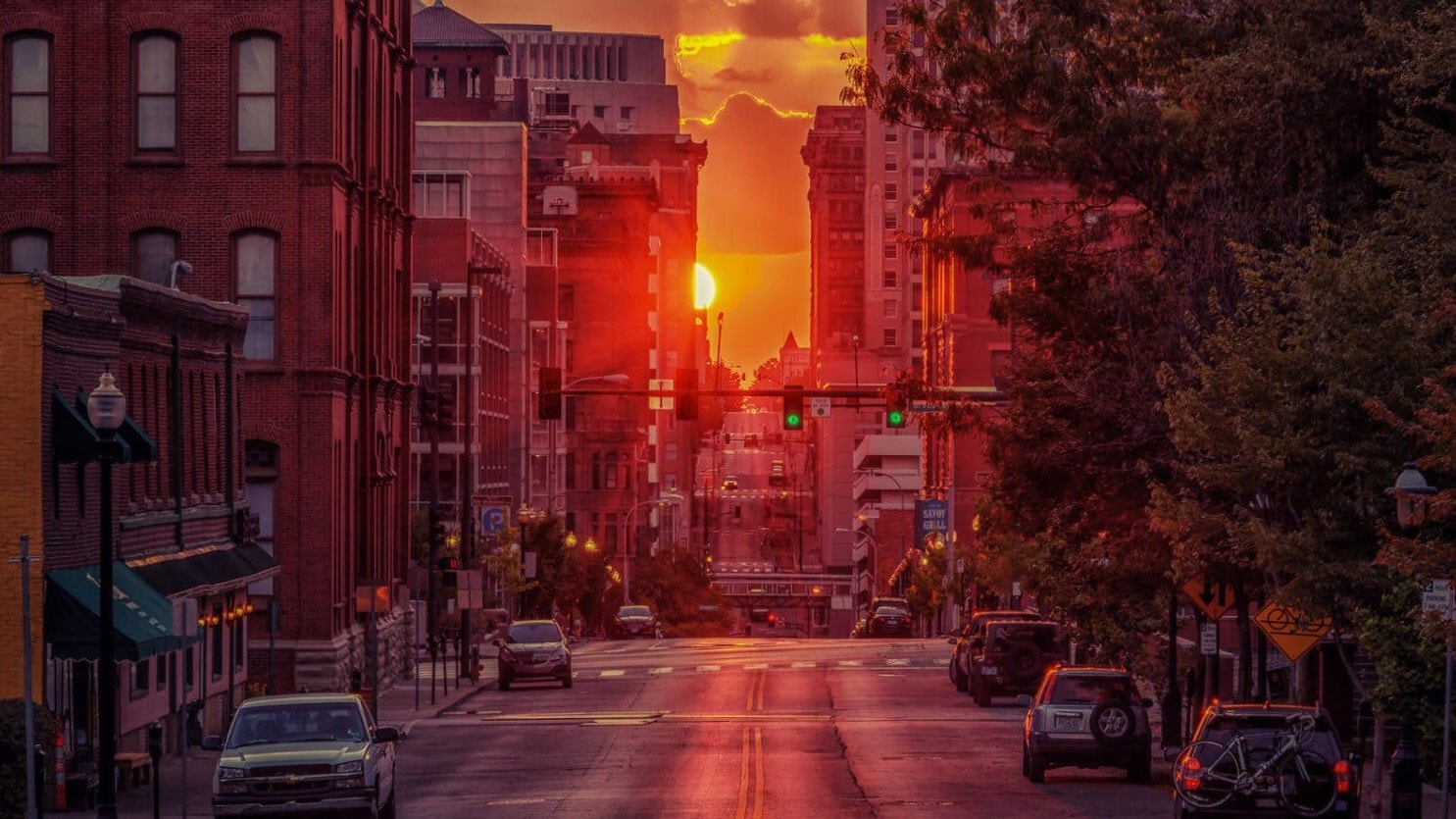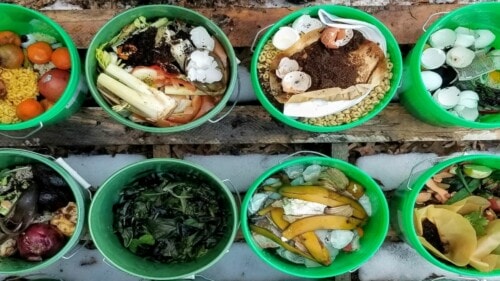Kansas City Area Seeks Unprecedented Sustainability Grants Mid-America Regional Council Submits Nearly $200 million in Grant Applications for Federal Funds
Published April 16th, 2024 at 6:00 AM
Above image credit: Clouds against a blue sky. (File photo)Go to the library and borrow an e-bike.
Take it down to Berkley Riverfront Park for a spin to Quindaro, a stop on the Underground Railroad during the Civil War.
Set aside coffee grounds and grapefruit skins for diversion to massive new composting operations that will cut the 300,000 tons of annual food waste flowing out of our garbage cans and into carbon-emitting, climate-changing landfills.
Residents of long-neglected corners of the city will get weatherization kits, rooftop solar panels and a bunch of new trees.
We can learn how to dedicate part of our backyards to native wildflowers and plants that were here when Native Americans stomped through today’s Brookside and Overland Park, supporting passing pollinators and songbirds.
All this and more will potentially be funded, soon, now that the Kansas City region submitted its applications for an unprecedented $200 million in federal grants over five years. If approved, the money promises to dramatically transform what it means to live, work and play in these parts for decades to come.
The application has been named “Kansas City – Anchoring Climate Transformation” or “KC-ACT.”
It is designed to help usher in a new 21st century era of sustainable electric power, transportation, buildings, farm and nature land practices and waste management.
The request was filed on April 1 to meet the deadline for the $4.6 billion special program spawned by the Inflation Reduction Act, signed into law by President Joe Biden in August 2022.
A city official working on sustainability for a major Southeast city told Flatland that major cities were encouraged by the feds to dream big and ask for at least $150 million.
The Kansas City region did that, and then some.
Big Ask, Big Plans
The formal ask totals $197,823,216.
What would that buy?
It would reduce the region’s climate-warming greenhouse gas emissions by 5.455 million metric tons over 25 years.
To put that into perspective, take the weight of all the steel used to build New York’s Empire State Building. Multiply that by 100. That would be about the weight of greenhouse gas emissions that the city would not emit by 2050 if the programs were funded in the Kansas City area, planners say.
The federal program is one cornerstone of the effort to jumpstart the economy after the COVID-caused recession and is considered the most significant action Congress has ever taken in the pursuit of clean energy.
The U.S. Environmental Protection Agency (EPA) has geared up massively to evaluate hundreds of applications for funding coming in from cities across the land.
“It is a monstrous effort on their side, just like it was for us to develop the application,” said Tom Jacobs, who helped coordinate the local submission.
“I never applied for a grant this large,” Jacobs said. “This was an extraordinarily comprehensive process. We did the best we could do.”
Jacobs is chief resiliency officer of the Mid-America Regional Council (MARC), which works with 119 cities in nine counties in Missouri and Kansas.
“This is an amalgamation of 40 projects,” he said.
“I never applied for a grant this large. This was an extraordinarily comprehensive process. We did the best we could do.”
Tom Jacobs, chief resiliency Officer of the Mid-America Regional Council
The city expects to learn the federal response by July. Then, Jacobs said, “I expect to enter six months of negotiations about scope, schedule and budget.”
At the top of the list is the city’s housing stock.
“Fifty percent of the ask is to support building energy efficiency and renewable energy improvements in low-income and disadvantaged communities,” he said.
That includes weatherizing 12,000 homes at a cost of about $1.4 million.
An additional $12 million will be marshaled to make energy efficiency improvements at 600 single-family homes and 15 multi-family buildings.
Dabbing caulk and installing low-flow shower heads and attic insulation has been underway locally for decades, Jacobs conceded. But there will be no problem finding more homes in need of $40 and $50 weatherization kits, he said.
“Evergy does this with folks. We’d probably lay this out with Evergy and nonprofits,” Jacobs said.
The list of projects awaiting federal support is varied.
Consider resilience hubs. Kansas City wants 15 of them.
One is being built by the Kansas City Public Library at its Lucile H. Bluford Branch at 3050 Prospect Avenue. More federal support from the new grant will go toward making the library itself super-energy efficient. Solar panels will be deployed. Residents can drop by and borrow an e-bike, learn how to plant a garden, pick up trees to plant in their yard and learn more about energy efficiency.
Grants totaling $1.5 million will help plant 140 electric vehicle charging stations in neighborhoods where they do not exist.

Up to $8 million will go to building two to three commercial composting sites. The Kansas City area throws out 300,000 tons of food waste a year. Experts said that the carbon emissions tied to food waste in landfills just about equals the carbon emissions from all jet traffic over America.
Kansas City would like to reduce that trash mountain and divert still edible food, when possible, Jacobs said. The bulk of the waste, responsible for belching out large volumes of greenhouse gases, needs to be composted and diverted from landfills.
The largest local commercial composting operation can handle 30,000 tons a year, Jacobs said. That must be augmented.
“We’d put out community calls for projects,” Jacobs said. “There is interest and capacity in the private sector to take this on.”
Diverting Food Waste
The federal grant request also includes funding to plant an additional 10,000 to 12,000 trees in Kansas City on top of the 10,000 the city currently is planting over five years. That is to green up neighborhoods that do not now have tree cover, making them hotter in summer.
Grants would pave the way for an addition of 15 miles of green streets and bike lanes.
More funds would be used to buy 5,400 e-bicycles to be shared or sold at flexible prices to make them affordable for low-income families.
“We want to scale impact on how folks get around and make communities more walkable and bike able,” Jacobs said.
Local Impact
The transformation will extend across the city — and back in time.
Alyssa Marcy, a long-range community planner with the Unified Government of Wyandotte County – Kansas City, said that the federal grant will allow it to extend trails and, in the process, transform neglected parts of the metro.
“The NE KCK Heritage Trail is a bike/ped shared-use path that connects Kaw Point to the Quindaro Townsite,” Marcy wrote in an email response to Flatland. “Once complete, the trail will provide connections to KCMO via the American Riverfront Heritage. Most importantly, the NE KCK Heritage Trail celebrates the heritage of NE KCK, a predominately black neighborhood that suffered from decades of disinvestment as a result of redlining.
“The NE KCK Heritage Trail Plan was adopted in 2022 along with the goDotte Countywide Strategic Mobility Plan, which prioritizes investment in multi-modal transportation to increase access to opportunity for our residents,” Marcy wrote. “The NE KCK Heritage Trail will not only celebrate the complex history of the area, but it will also provide more sustainable mobility options, catalyze economic development, and improve health outcomes.”
The grant-funded metro transformation will extend to the very roots of today’s city.
Consider the work of Deep Roots KC, which last year met with 50 local families to look over their yards, identify harmful invasive species of plants and shrubs and recommend which indigenous plants, flowers, shrubs and trees should be planted to help the local ecosystem thrive, according to Stacia Stelk, director of Deep Roots KC.
This summer growing season, the group, which employs five people, plans to meet with 80 families.
The region’s epic sustainability grant ask, Stelk said, would be a “game changer,” enabling the nonprofit to work with 600 residential homeowners and renters over five years, she said.
With the grant, Deep Roots, which now employs five people, could add one or two more workers.
In addition to providing guidance to interested residents, it plans to source and provide plants and seeds to broaden the range of native landscapes.
Planting native species of flora will help sustain struggling butterfly species.
It would allow songbirds to return and proliferate, filling neighborhood with warbles and avian strains that have waned in recent years and decades, Stelk said.
Flatland contributor Martin Rosenberg is a Kansas City journalist and host of the Grid Talk podcast on the future of energy.





